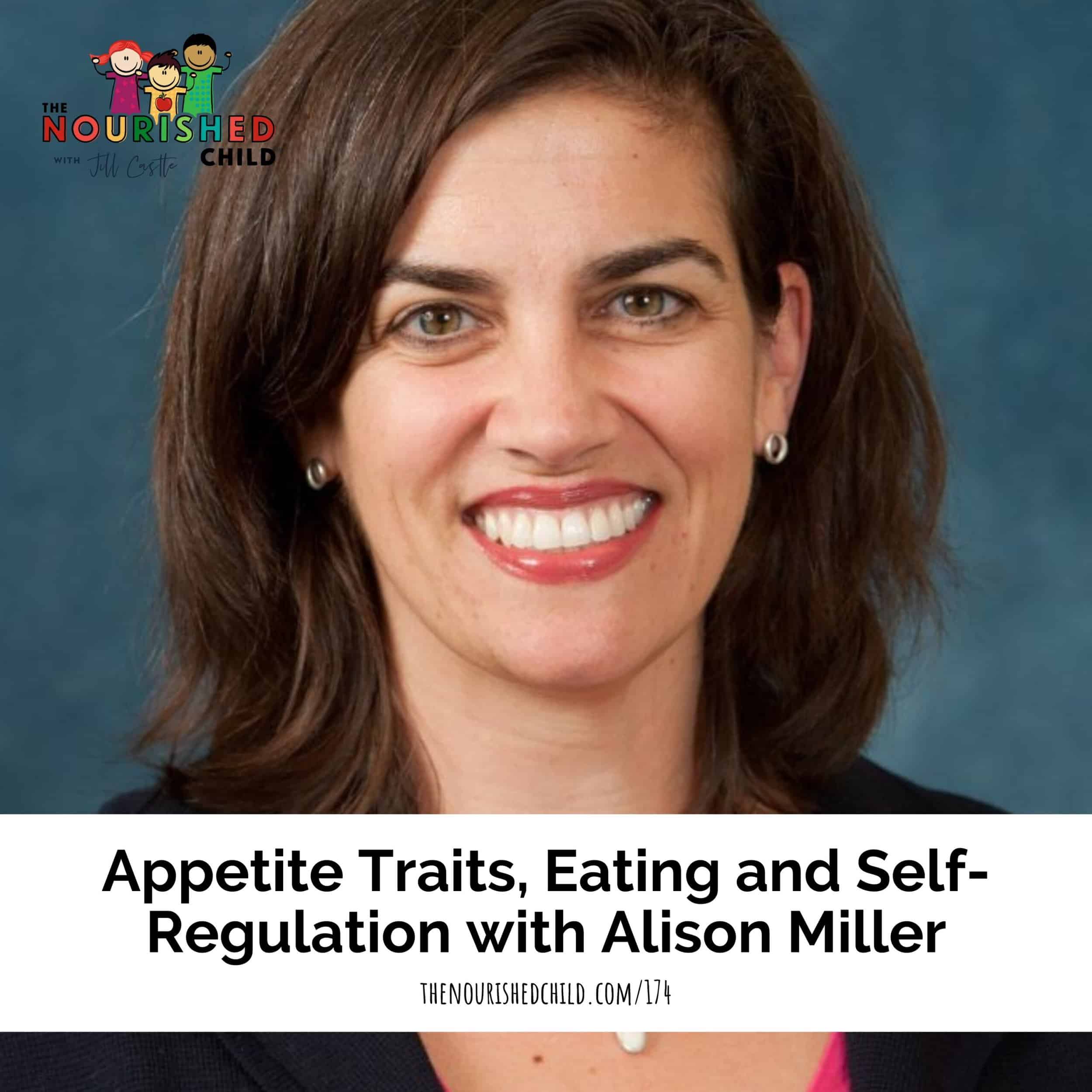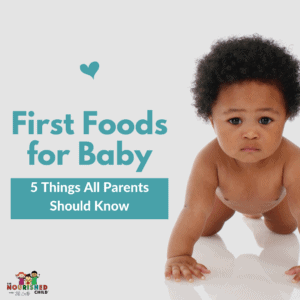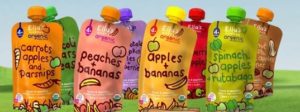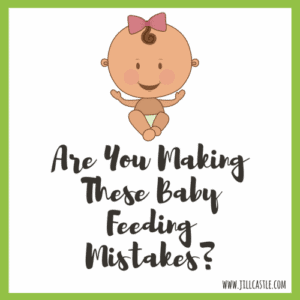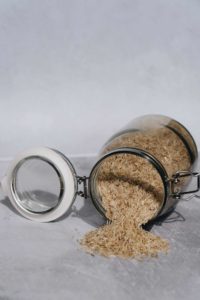Best Iron-Rich Foods for Babies
November 11, 2022
Iron is a critical nutrient during childhood. Learn easy ways to add iron-rich foods for babies during complementary feeding to ensure your infant meets his nutritional needs.
Did you know that as a baby’s brain develops, it triples in size during the first three years?
Iron is one of the most critical nutrients during childhood because it plays an essential role in brain development.

Iron deficiency is a common nutrient childhood deficiency worldwide. But many foods manufactured in the U.S. are fortified with iron, so deficiency isn’t as common here.
In the first 6 months, infants rely on formula or breast milk to meet their nutrient requirements. Then, solid foods fill the gap to help provide all the nutrients babies need for healthy growth and development.
The risk of iron deficiency increases between 6 – 24 months old (and during the teen years for girls).
Let’s dive into the best iron-rich foods for babies, whether you’re spoon-feeding or baby-led weaning.
How Much Iron Does a Baby Need Daily?
Iron is a mineral that can build up in the body. Infants begin storing iron even before they’re born. And depending on the mother’s diet, babies should have enough iron to sustain them for approximately the first 4-6 months.
Around 6 months, babies need to start eating iron-containing complementary foods, including iron-fortified baby cereals, especially if they’re breastfeeding because the iron content of breast milk declines and iron needs increase.
Here are the daily iron requirements for babies and toddlers:
- 0 – 6-month-old infants, Adequate Intake (AI) is 0.27 mg*
- 7 – 12-month-old infants, DRI is 11 mg
- 1 – 3-year-old toddlers, the DRI is 7 mg
*Since all of an infant’s nutrients come from breast milk or formula, the DRI isn’t established for ages 0-6 months. So Adequate Intake is used instead.
What Are the Best Sources of Iron for Babies?
There are three primary sources of iron for babies: breast milk, standard iron-fortified formula, and complementary foods. Let’s take a closer look at each source of iron.
Breast Milk
The World Health Organization (WHO) recommends exclusive breastfeeding for the first 6 months. The amount of iron provided by breast milk depends on the quantity of the mother’s diet.
There are some circumstances when breast milk may not provide enough iron for your baby. If you’re concerned that your baby isn’t getting enough iron from breast milk, ask your pediatrician whether they recommend a supplement.
Breast-fed babies who are starting solids benefit from iron-rich foods.
Iron-Fortified Formula
Most baby formula in the U.S. is fortified with iron and meets your baby’s daily iron needs. Standard formulas contain 12 mg/dl of iron, enough to meet your growing baby’s needs.
As long as it’s not watered down…
Watering down formula reduces the concentration of nutrients and is dangerous for babies. It can lead to deficiencies and slow growth and development.
Also, babies don’t need water before 6 months of age. Introducing more water than the amount required to prepare the formula can cause an electrolyte imbalance.

Complementary Foods
When your little one is 6 months old, it’s time to introduce solids! (As long as they’re showing signs of developmental readiness.)
When you introduce solids to your baby’s diet, he’ll rely less and less on breast milk or formula for nutrients. So, it’s vital to offer nutritious foods during weaning.
If babies get most of their nutrition from breast milk or formula, do they need nutrient-rich foods too?
Yes!
Babies benefit from solid foods packed with vitamins and minerals even while they’re still nursing or on formula for two big reasons:
- Babies can develop a taste preference for early foods, so it’s best to offer nutrient-rich foods like fruits and veggies early
- Nutritious foods compensate for the nutrients babies lose as you decrease formula or breastfeeding when you offer complementary feeding at 7 – 12 months of age
Sometimes pediatricians recommend introducing solids in a specific order, starting with rice cereal.
There are pros and cons to this single grain baby cereal. It’s fortified in iron, easy to digest and rice is a low allergenic food. The downside is that rice cereal tops the list of arsenic-containing baby food.
But, according to the American Academy of Pediatrics (AAP), you don’t need to offer your baby’s first foods in a particular order.
Whether you spoon-feed or practice baby-led weaning, there are three main concerns: choking, allergies and iron.
Offer purees or foods modified to a safe texture and size to reduce the risk of choking.
Recent studies show that introducing allergens to babies early may reduce the risk of food allergies. This is great news!
But parents should still use caution when introducing new foods to babies and introduce one new food at a time. After 1 to 3 days, you can introduce another new food.
As for iron, your baby’s iron stores are used by 6 months of age. So, a baby’s first foods must contain iron to support the rapid brain development that’s happening during the first three years.
Let’s dive into the best iron-rich complementary solids and purees for babies.
Best Iron-Rich Foods for Spoon-feeding
You can make your own baby food or use stage two purees to spoon-feed your baby.
1. Pureed meat
Pureed chicken, beef, or lamb are all great sources of iron. You can make your own purees or buy them pre-made at the store. Just make sure to check the labels to ensure they don’t contain any added salt, sugar, or other ingredients.
2. Fortified cereals
Fortified baby cereals are another great option for iron-rich spoon-fed meals. You can vary the type of cereal to reduce the amount of rice cereal you offer your little one. Single grain oatmeal is a great choice, or you can try quinoa, barley, or brown rice cereals.

3. Lentils
Lentils are a nutritious powerhouse and an excellent source of iron for babies. They’re also easy to puree, so they’re perfect for spoon-feeding. You can cook them from scratch or buy them pre-cooked in a can. Drain and rinse them before pureeing to lower the amount of sodium.
4. Beans
Black beans, kidney beans, navy beans, and lentils are all great options for babies (and adults!). You can puree them on their own or mix them into other food purees like vegetables or baby cereal for added flavor and nutrition.
5. Dark leafy greens
Dark leafy greens like spinach and kale are packed with nutrients, including iron. Cook them first, and they’ll be much easier to blend into a smooth consistency. You can also try adding them to other food purees to add some extra nutrition.
Best Iron-Rich Foods for Baby-led Weaning
Baby-led weaning (BLW) is a great way to introduce your baby to solid foods. With BLW, your baby can self-feed from the very beginning and is in control of how much they eat and what they eat.
Food for baby-led weaning needs to be modified to the right texture and size to reduce the risk of choking.
1. Meat
Beef, pork, lamb, chicken and turkey are all excellent sources of iron. Look for ground meat or soft meats cut into finger-length pieces so it’s easy for your baby to pick up and eat.
2. Seafood
Low mercury fish is a great source of iron. If you’re feeding seafood to your baby, be sure to cook it thoroughly to reduce the risk of food poisoning. Run your hand across fillets of fish to check for small bones first.
Stick to 2 servings of low-mercury fish a week.
The lowest mercury fishes are anchovies, Atlantic mackerel, catfish, clams, crab, crawfish, flounder, haddock, mullet, oysters, plaice, pollock, salmon, sardines, scallops, shad, shrimp, sole, squid, tilapia, trout, and whiting.
[Related: 5 Tips to Help Kids Eat More Fish]
3. Eggs
Eggs are another great source of iron for baby-led weaning. You can hard boil them, scramble them, or make them into mini omelets or quiches. Avoid added salt, but feel free to use eggs as a vehicle to introduce other seasonings.
4. Beans and lentils
Beans and lentils are packed with nutrients, including iron. They’re also easy for babies to eat since they can be mashed, shaped into bite-size patties, or pureed as needed. Rinse, strain, and cook them thoroughly before feeding them to your baby.
Once your baby has developed the pincer grasp, they can pick up one bean at a time!
3. Tofu
Tofu is a great plant-based source of iron for babies that’s also an excellent source of protein and calcium. It can be pureed, diced into small pieces, or offered as finger food. Tofu is naturally soft and easy for your baby to “chew” and swallow.
4. Fortified Foods
Some examples of fortified foods include cereal, bread, oatmeal, and pasta. Look for brands that say “enriched” or “fortified” on the label. These products have the added benefit of other nutrients as well.
Even during BLW, I recommend offering cereal made for babies because they’re packed with the nutrients babies need during the first year. You can help your little one by preloading a spoon with cereal. It may take a few tries until they get the hang of self-feeding with a utensil.
Learn More About the Essential Nutrients During Childhood
Be sure to check out my guide, Nutrients for Kids: Advanced Guide, which dives into the 7 most critical nutrients for growth and development during childhood. And read, The Ultimate Guide to Baby’s Nutrition in the First Year.
Got a teen? Read The Best Iron-Rich Foods for Teens.
What’s your baby’s favorite iron-rich food?


